如何确定谓语动词的单复数形式
- 格式:docx
- 大小:22.80 KB
- 文档页数:10
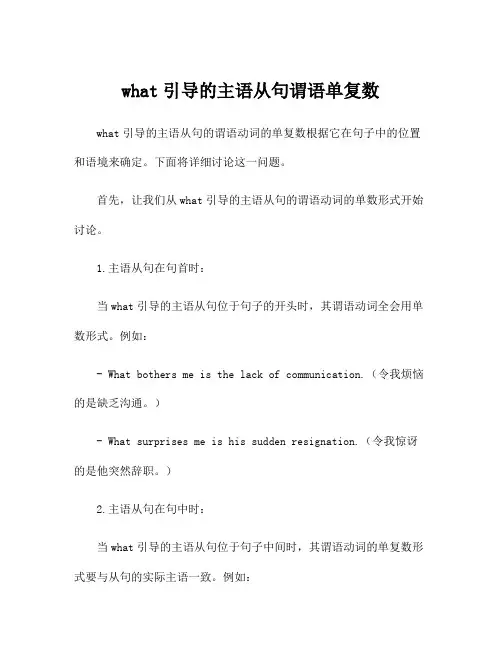
what引导的主语从句谓语单复数what引导的主语从句的谓语动词的单复数根据它在句子中的位置和语境来确定。
下面将详细讨论这一问题。
首先,让我们从what引导的主语从句的谓语动词的单数形式开始讨论。
1.主语从句在句首时:当what引导的主语从句位于句子的开头时,其谓语动词全会用单数形式。
例如:- What bothers me is the lack of communication.(令我烦恼的是缺乏沟通。
)- What surprises me is his sudden resignation.(令我惊讶的是他突然辞职。
)2.主语从句在句中时:当what引导的主语从句位于句子中间时,其谓语动词的单复数形式要与从句的实际主语一致。
例如:- The problem is what causes the delays.(问题是导致延误的原因。
)- He has no idea what is needed for the project.(他不知道项目需要什么。
)3.主语从句后面跟有附加从句时:当what引导的主语从句后面有一个附加从句时,谓语动词的单复数形式要根据附加从句的实际主语来确定。
例如:- What he said and did have caused a lot of trouble.(他说和做的事情引起了很多麻烦。
)- What the children need and want is love and attention.(孩子们需要和想要的是爱和关注。
)接下来,我们来讨论what引导的主语从句的谓语动词的复数形式。
1.主语从句以复数名词开头时:当what引导的主语从句以复数名词开头时,其谓语动词通常使用复数形式。
例如:- What interests me are the different cultures around the world.(令我感兴趣的是世界各地的不同文化。

谓语动词用单数的情况 Company number:【WTUT-WT88Y-W8BBGB-BWYTT-19998】谓语动词用单数的情况1.动名词短语、不定式短语、名词性从句做主语,谓语用单数。
Buying clothes is often a time-consuming job because those clothes that a person likes are rarely the cones that fit him or her. (1987年考研题) To understand the situation completely requires more thought than has been given thus far.2.表示时间、距离、金额、重量、面积、体积、容积等度量的名词短语做主语时,谓语用单数。
Two weeks was too long Five times five makes twenty five3.一般用and连接的两个单词或短语做主语时候,谓语用复数,但是下面用and连接的主语表示一个概念,谓语用单数: law and order 法制 soap and water 肥皂水 a cup and saucer 茶杯碟子 fork and knife 刀叉 the needle and thread 针线 trial and error 反复尝试,不断摸索 horse and carriage 马车 time and tide 岁月 bread and butter 奶油面包 the ebb and flow 盛衰,潮涨潮落如: If law and order not preserved, neither the citizen nor his property is safe. A. is B. are C. was d. were 答案:A。
4.表示学科和某些疾病名称的名词是复数形式,作主语时候谓语动词用单数形式Linguistics is a branch of study on human language.5.有些名词形式上是复数,意义上是单数,根据意义一致原则动词用单数 The chaos was stopped by the police The news is a great encouragement to us A series of debates between the lectures was scheduled for the next weekend.6.用and 连接的成份表示一个单一概念时候,动词谓语用单数形式 Bread and butter is our daily food Time and tide waits for no man《和3同》二.谓语用复数情况1.由and, both …and, 连接的并列主语,和both ,a few, many ,several 等修饰语后面谓语动词通常用复数形式。
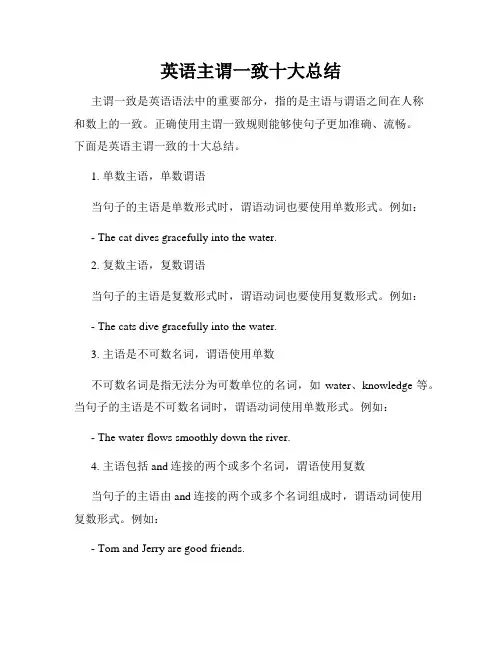
英语主谓一致十大总结主谓一致是英语语法中的重要部分,指的是主语与谓语之间在人称和数上的一致。
正确使用主谓一致规则能够使句子更加准确、流畅。
下面是英语主谓一致的十大总结。
1. 单数主语,单数谓语当句子的主语是单数形式时,谓语动词也要使用单数形式。
例如:- The cat dives gracefully into the water.2. 复数主语,复数谓语当句子的主语是复数形式时,谓语动词也要使用复数形式。
例如:- The cats dive gracefully into the water.3. 主语是不可数名词,谓语使用单数不可数名词是指无法分为可数单位的名词,如water、knowledge等。
当句子的主语是不可数名词时,谓语动词使用单数形式。
例如:- The water flows smoothly down the river.4. 主语包括and连接的两个或多个名词,谓语使用复数当句子的主语由and连接的两个或多个名词组成时,谓语动词使用复数形式。
例如:- Tom and Jerry are good friends.5. 主语包括either/or、neither/nor连接的两个名词,谓语与最近的名词保持一致当句子的主语由either/or、neither/nor等连接的两个名词组成时,谓语动词与最近的名词在人称和数上保持一致。
例如:- Either Tom or Jerry is responsible for the mess.6. 主语是集体名词,谓语根据上下文确定单复数集体名词指代一群人或事物的总称,如team、family等。
谓语动词的单复数形式根据上下文来确定。
例如:- The family goes to the park every weekend.7. 主语是某些固定短语时,谓语使用单数某些固定短语作为主语时,谓语动词使用单数形式。
例如:- Bread and butter is a common breakfast choice.8. 主语是以each、every、everyone、everything等开头时,谓语使用单数当句子的主语以each、every、everyone、everything等词开头时,谓语动词使用单数形式。
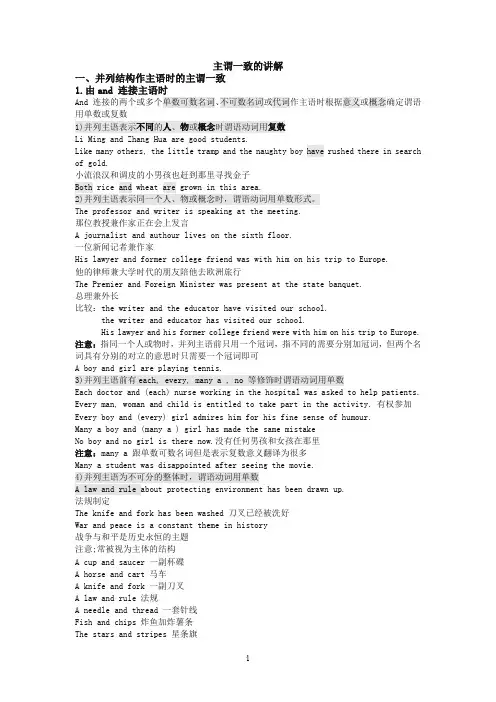
主谓一致的讲解一、并列结构作主语时的主谓一致1.由and 连接主语时And 连接的两个或多个单数可数名词、不可数名词或代词作主语时根据意义或概念确定谓语用单数或复数1)并列主语表示不同的人、物或概念时谓语动词用复数Li Ming and Zhang Hua are good students.Like many others, the little tramp and the naughty boy have rushed there in search of gold.小流浪汉和调皮的小男孩也赶到那里寻找金子Both rice and wheat are grown in this area.2)并列主语表示同一个人、物或概念时,谓语动词用单数形式。
The professor and writer is speaking at the meeting.那位教授兼作家正在会上发言A journalist and authour lives on the sixth floor.一位新闻记者兼作家His lawyer and former college friend was with him on his trip to Europe.他的律师兼大学时代的朋友陪他去欧洲旅行The Premier and Foreign Minister was present at the state banquet.总理兼外长比较:the writer and the educator have visited our school.the writer and educator has visited our school.His lawyer and his former college friend were with him on his trip to Europe. 注意:指同一个人或物时,并列主语前只用一个冠词,指不同的需要分别加冠词,但两个名词具有分别的对立的意思时只需要一个冠词即可A boy and girl are playing tennis.3)并列主语前有each, every, many a , no 等修饰时谓语动词用单数Each doctor and (each) nurse working in the hospital was asked to help patients. Every man, woman and child is entitled to take part in the activity. 有权参加Every boy and (every) girl admires him for his fine sense of humour.Many a boy and (many a ) girl has made the same mistakeNo boy and no girl is there now.没有任何男孩和女孩在那里注意:many a 跟单数可数名词但是表示复数意义翻译为很多Many a student was disappointed after seeing the movie.4)并列主语为不可分的整体时,谓语动词用单数A law and rule about protecting environment has been drawn up.法规制定The knife and fork has been washed 刀叉已经被洗好War and peace is a constant theme in history战争与和平是历史永恒的主题注意;常被视为主体的结构A cup and saucer 一副杯碟A horse and cart 马车A knife and fork 一副刀叉A law and rule 法规A needle and thread 一套针线Fish and chips 炸鱼加炸薯条The stars and stripes 星条旗2.由(either)…or 或neither…nor 等连接的主语时由 either…or, neither…nor, or, not only…but(also)…连接主语时,谓语动词陈述句中就近原则Either you or Jane is to be sent to New York.要么你要么简被派往纽约Neither you nor he has finished the experiment.Neither the teacher nor the students like this piece of music. 都不喜欢这首曲子Not only the old farmer but also his family were friendly to me.Not only his friends but also he himself is looking forward to taking part in the party.3.主语由肯定否定两部分构成谓语跟肯定部分走Not you but I am to answer the questionI, not you, am to answer the question.二、单一主语的主谓一致1.名词本身自带s作主语时1)学科名词: physics 物理 mathematics/maths 数学 economics 经济学 politics政治学新闻; news体操:GymnasticsAs we know, Physics is a fundamental subject in science.物理是自然科学中的一门基础学科Mathematics is a required course for middle school students.数学是中学生的一门必修课Einstein once said ,“Politics is much more difficult than physics.”注意:当mathematics 表示运算时谓语动词用单数复数都可If my mathematics is/are right, the answer is 56.如果我的运算正确,答案就是56 The television news is at 7 o’clock in the evening every dayGymnastics is my sister’s favourite sport2)有些名词单复数同行根据是单数概念还是复数概念判断谓语 means方式方法 aircraft 飞机works 工厂 crossroads十字路口 deer 鹿 sheep 羊 fish 鱼This works was build in 1982 这座工厂是By far, three steelworks have been closed down in this cityThis means of transport has been triedAll possible means have been tried3)由两部分组成的物体名词作主语时,谓语动词用复数chopsticks筷子 compasses 圆规glasses眼镜 gloves手套Jeans牛仔裤 pants裤子scissors剪子 shoes鞋子shorts短裤 socks短袜trousers裤子My trousers are white and his clothes are black.我的裤子是白色的他的衣服是黑色的Why are your shoes so dirty?注意;如果这些词由单位词(a pair of , a suit of , a piece of , a kind of 等)修饰时,单位词的单复数决定谓语动词的单复数A pair of scissors is lying in that drawer.These kinds of glasses are popular this summer.4)表示国家、人名、书名、组织机构等的专有名词作主语时,谓语动词用单数The united States is a developed countryThe New York Times is widely read in the world.5)以-s 结尾的群岛、山脉、海峡、瀑布等专有名词谓语动词用复数The Himalayas have a magnificent variety of plants.植物种类繁多The Niagara Falls are splendid waterfalls.6)以-S结尾的名词作主语时谓语动词用复数belongings财产 clothes衣服 plasticsearnings收入 goods货物leavings剩余 savings储存All the goods are very expensive.2.集体名词作主语时1)mankind, humanity, man 作主语时,谓语一般用单数Only man knows how to cook. 只有人懂得烹饪【注】mankind 表示“人(类)”有时表示复数意义,尤其是其表语是复数时:Mankind are intelligent animals. 人是理智的动物.2)people, police, cattle, youth等作主语时,只有单数形式, 但却表示复数意义谓语动词用复数The police are investigating the riot. 正在调查暴乱事件The cattle are grazing the the field 正在牧场吃草Many cattle were killed for this. 就因为这个原因宰了不少牲畜【注】people作民族讲时有复数形式.如: There are 56 peoples in China3)family, crowd 等作主语时,根据概念确定谓语动词这类集体名词有:Army, assembly议会集会 audience band class club committee company congress议会youth crew 全体工作人员 crowd enemy family gang团伙government group herd牧群 jury population public team强调整体用单数谓语强调个体用复数谓语The family is going to move to New YorkThe family have different opinions about their going abroadThe football club committee arranges all the matchesThe football club committee have decided to dismiss him.比较:A family , a group , a class 做主语时用单数谓语Families, groups, classes 作主语时用复数谓语A group is coming to the zoo.一队人正朝着动物园走来4)baggage / luggage(行李), clothing(衣服), furniture(家具), machinery(机器), poetry(诗), scenery(风景), jewelry(珠宝), equipment(设备)等,是不可数名词,只用单数形式,不用不定冠词(当然更不能用数词)Our clothing protects us from [against] the cold. 我们的衣服可以御寒.Have you checked all your baggage? 你所有行李都托运了吗?【注】machinery, poetry, jewelry, scenery等相应的个体可数名词是 machine, poem, jewel, scene等.如:a poem / a piece of poetry(一首诗),many machines / much machinery / many pieces of machinery(许多机器).5)hair的用法hair(头发,毛发)指全部头发或毛发时,为集合名词(不可数);指几根头发或毛发时,为个体名词(可数):My hair has grown very long. 我的头发已长得很长了.The police found two hairs there. 警察在那儿找到了两根头发.6)fruit的用法fruit(水果)作为集合名词,它通常是不可数的:He doesn’t eat much fruit. 他不大吃水果.He is growing fruit in the country. 他在乡下种水果.但是,当要表示种类时,它可视为可数名词,即a fruit 指一种水果,fruits 指多种水果.比较:Some fruits have thick skins. 有些水果皮很厚.3.非谓语动词或从句作主语时1)非谓语动词或从句作主语时谓语动词用单数To improve agricultural land needs a lot of money.改善耕地质量需要投入大量的资金To see is to believeSwimming is a good way to keep healthHow they will solve the problem remains to be seenWhether she will come is not known2)多个非谓语动词作主语,表达一个概念谓语用单数,表达不同概念谓语用复数Going to be early and getting up early is good for your health.早睡早起一个概念Reading books and playing table tennis are my great pleasure.读书和打乒乓球Listening, speaking, reading and writing are all important.To be strict with oneself and to be kind to others are good qualities of a person三、其他情况的主谓一致1.表示距离、时间、长度、金额、质量等的复数名词作主语时常被看作是整体谓语动词用单数这类复数名词有:miles, dollars, pounds, kilograms公斤千克, kilometres公里, centimetres,厘米 millimetres毫米, seconds, hours, years等Five dollars seems a fair price 是一个公道的价格Two kilometres is not very far for the young manFive hours is a short time for such a difficult job2.如果强调数目谓语动词用复数One hundred cents make a dollarMore than twenty years have passed since they got married.3.算数中的谓语动词一般用单数形式,有时也用复数Five times eight is/are fortyFour and eight makes/make twelveSixty minus seven leaves fifty-threeForty-eight divided by six is eight4.复合不定代词作主语时谓语动词用单数Everyone something anybody nowhereEveryone in the class was surprised at the newsListen! Someone is knocking at the door.Is anyone going to tell him the news?5.each one of…, every one of …, anyone of…, one of…, 等作主语时谓语用单数Each of the girl in our class has a balloon 我们班每个女孩都有一个气球Each of the students was asked to speak for three minutes.Every one of them is familiar to me. 我对他们都很熟悉6.each , every 作形容词修饰主语时谓语动词用单数但是each 作复数主语的同位语时谓语用复数Each/Every boy in our class has a skateboard一副滑板They each have a stateboardEach/Every student has an English-Chinese dictionaryThe students each have an English-Chinese dictionary7.none of + 不可数名词谓语用单数none of,neither of, + 可数名词复数/复数代词 + 谓语动词单数复数都可either of ,None of that money in the desk is his 不可数名词None of his classmates knows the truth.= None of his classmates know the truth Neither of the statements is true = Neither of the statements are true 两种说法没有一个真实Either of the qualifications is acceptable = Either of the qualifications are acceptable8.neither 与 either 做形容词修饰单数名词时谓语动词用单数Either qualification is acceptable两种资格中的任何一种都可以接受Neither qualification is acceptable9.分数百分数+ of + 名词,some of , plenty of, a lot of, lots of, most of, the rest of, all(of), half(of) 谓语常与of 后面的名词一致分数/百分数 + of + 复数名词/ 复数代词谓语动词用复数分数/百分数 + of + 单数名词/单数代词谓语动词用单数不可数名词Two thirds of the students support the plan复数名词One tenth of them are suffering from this kind of illness.复数代词Three fourths of the surface of the earth is sea单数名词Eighty percent of the employees in the company are from Beijing百分数复数名词Thirty percent of its area is flooded each year.百分数单数名词The rest of the money belongs to youThe rest of the students speak for it.Half of the apple is rottenHalf of the apples are rotten10.more(…) than one…结构作主语时More(…)than one…+ 单数名词谓语用单数More + 复数名词 + than one 谓语用复数More than two + 复数名词谓语用复数More than one white rose has bloomed in the gardenMore white roses than one have bloomed in the gardenMore than two white roses have bloomed 两个以上的的白玫瑰开了11.a number of + 复数名词谓语用复数许多的The number of + 名词谓语动词用单数…的数量A number of trees are green in AprilA great number of tourists have been to the Great WallA large number of worker were out of work because the factory was destroyed in flood.The number of students in the computer class is limited to ten.The number of workers who were out of work was 1,000.12.there/here…引导句子时就近原则There are some chairs and a table in the roomThere is a table and some chairs in the roomHere are some gifts for youHere is a book, a pen and some paper for you.13.当主语后接修饰语时With, along with, together with, but, besides, except, like, including, in addition to, as well as, rather than, 谓语动词与前面的主语保持一致A library with five thousand books is offered to the nation as a gift被作为礼物送给了这个国家The teacher, along with her students, is going to attend the lecture 听报告A peasant, together with some soldiers, is about to help us.All but one have arrived here.除了一个人外所有人都到了No one except two students was late for class.再没有其他人上课迟到The garage, in addition to the house, was burned.She as well as the other girls is going to another supermarked.You as well as I are wrong.The father, rather than the brother, is responsible.父亲而不是兄弟们应当负责14.The+ 形容词做主语时表示一类人用复数谓语表示抽象概念用单数谓语The injured were carried away on stretchers.用担架抬走了The old are more likely to catch cold than the youngThe rich are for the decision but the poor are against it.The young are always full of vitality充满了活力The unknown is always something to be feared 未知的东西总是令人害怕The beautiful is not always the good, and the good is not always the true.美未必是善善未必是真The true is to be distinguished from the false真应与假相区别The good is what people like 人们总是喜欢美好的东西In many stories, the good are well rewarded and the bad are punished.好人有好报坏人有怀抱15.all做主语时指一切表示单数概念用单数谓语,指具体人或物用复数谓语All has been tried一切都试过了All were silent 大家都一言不发All was silent 万籁俱寂All are here now 大家都在16.由 a kind of, this kind of, many kinds of, 名词+of this kind, a type of asort of 谓语动词根据of 后面的名词来定A new type of machine is on show now. Machines of this kind are made in Wuhan欢迎您的下载,资料仅供参考!致力为企业和个人提供合同协议,策划案计划书,学习资料等等打造全网一站式需求。
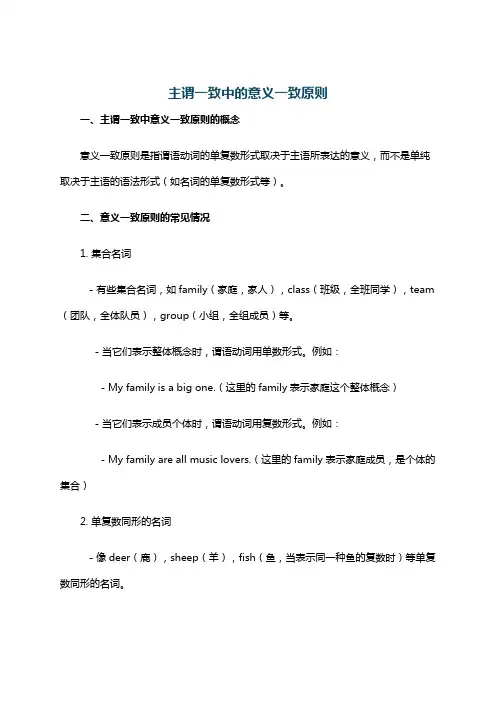
主谓一致中的意义一致原则一、主谓一致中意义一致原则的概念意义一致原则是指谓语动词的单复数形式取决于主语所表达的意义,而不是单纯取决于主语的语法形式(如名词的单复数形式等)。
二、意义一致原则的常见情况1. 集合名词- 有些集合名词,如family(家庭,家人),class(班级,全班同学),team (团队,全体队员),group(小组,全组成员)等。
- 当它们表示整体概念时,谓语动词用单数形式。
例如:- My family is a big one.(这里的family表示家庭这个整体概念)- 当它们表示成员个体时,谓语动词用复数形式。
例如:- My family are all music lovers.(这里的family表示家庭成员,是个体的集合)2. 单复数同形的名词- 像deer(鹿),sheep(羊),fish(鱼,当表示同一种鱼的复数时)等单复数同形的名词。
- 如果这类名词前有a/an或者表示单数概念的限定词时,谓语动词用单数;如果表示复数概念(如数量大于1或者有表示复数的限定词等),谓语动词用复数。
例如:- A sheep is eating grass on the hill.- There are some sheep in the field.3. 以 -s结尾但意义为单数的名词- 一些学科名词,如mathematics(数学),physics(物理),politics(政治)等,虽然以 -s结尾,但表示的是单数意义,谓语动词用单数形式。
例如: - Mathematics is not an easy subject for some students.- 还有一些疾病名称,如measles(麻疹),mumps(腮腺炎)等,谓语动词也用单数形式。
例如:- Measles is a kind of infectious disease.4. 表示时间、距离、重量、金额等复数形式的名词作主语时- 如果将这些复数形式的名词看作一个整体概念,谓语动词用单数形式。
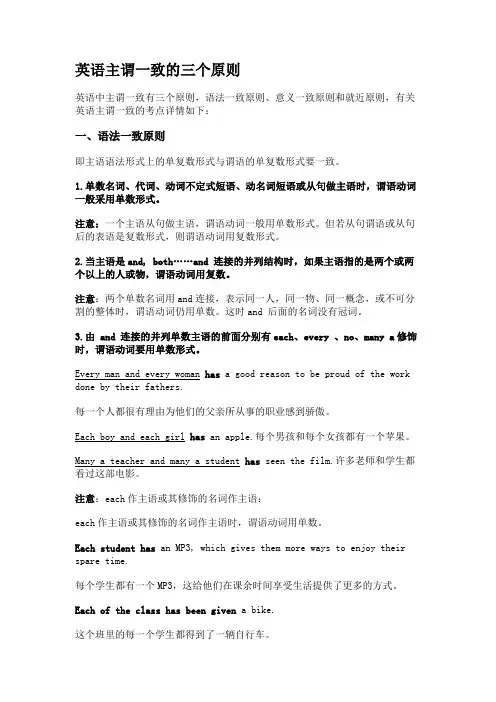
英语主谓一致的三个原则英语中主谓一致有三个原则,语法一致原则、意义一致原则和就近原则,有关英语主谓一致的考点详情如下:一、语法一致原则即主语语法形式上的单复数形式与谓语的单复数形式要一致。
1.单数名词、代词、动词不定式短语、动名词短语或从句做主语时,谓语动词一般采用单数形式。
注意:一个主语从句做主语,谓语动词一般用单数形式。
但若从句谓语或从句后的表语是复数形式,则谓语动词用复数形式。
2.当主语是and, both……and 连接的并列结构时,如果主语指的是两个或两个以上的人或物,谓语动词用复数。
注意:两个单数名词用and连接,表示同一人,同一物、同一概念,或不可分割的整体时,谓语动词仍用单数。
这时and 后面的名词没有冠词。
3.由 and 连接的并列单数主语的前面分别有each、every 、no、many a修饰时,谓语动词要用单数形式。
Every man and every woman has a good reason to be proud of the work done by their fathers.每一个人都很有理由为他们的父亲所从事的职业感到骄傲。
Each boy and each girl has an apple.每个男孩和每个女孩都有一个苹果。
Many a teacher and many a student has seen the film.许多老师和学生都看过这部电影。
注意:each作主语或其修饰的名词作主语:each作主语或其修饰的名词作主语时,谓语动词用单数。
Each student has an MP3, which gives them more ways to enjoy their spare time.每个学生都有一个MP3,这给他们在课余时间享受生活提供了更多的方式。
Each of the class has been given a bike.这个班里的每一个学生都得到了一辆自行车。
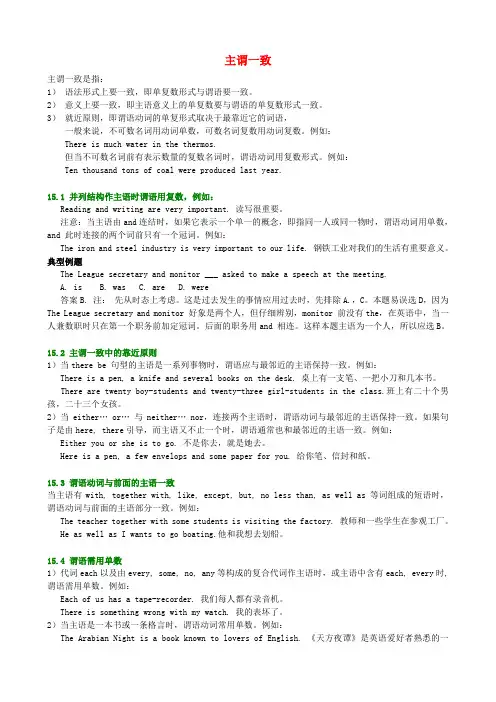
主谓一致主谓一致是指:1)语法形式上要一致,即单复数形式与谓语要一致。
2)意义上要一致,即主语意义上的单复数要与谓语的单复数形式一致。
3)就近原则,即谓语动词的单复形式取决于最靠近它的词语,一般来说,不可数名词用动词单数,可数名词复数用动词复数。
例如:There is much water in the thermos.但当不可数名词前有表示数量的复数名词时,谓语动词用复数形式。
例如:Ten thousand tons of coal were produced last year.15.1 并列结构作主语时谓语用复数,例如:Reading and writing are very important. 读写很重要。
注意:当主语由and连结时,如果它表示一个单一的概念,即指同一人或同一物时,谓语动词用单数,and 此时连接的两个词前只有一个冠词。
例如:The iron and steel industry is very important to our life. 钢铁工业对我们的生活有重要意义。
典型例题The League secretary and monitor ___ asked to make a speech at the meeting.A. isB. wasC. areD. were答案B. 注:先从时态上考虑。
这是过去发生的事情应用过去时,先排除A.,C。
本题易误选D,因为The League secretary and monitor 好象是两个人,但仔细辨别,monitor 前没有the,在英语中,当一人兼数职时只在第一个职务前加定冠词。
后面的职务用and 相连。
这样本题主语为一个人,所以应选B。
15.2 主谓一致中的靠近原则1)当there be 句型的主语是一系列事物时,谓语应与最邻近的主语保持一致。
例如: There is a pen, a knife and several books on the desk. 桌上有一支笔、一把小刀和几本书。
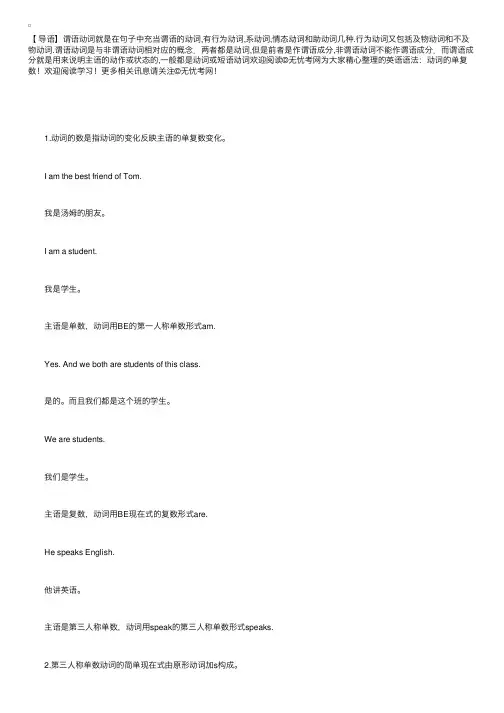
【导语】谓语动词就是在句⼦中充当谓语的动词,有⾏为动词,系动词,情态动词和助动词⼏种.⾏为动词⼜包括及物动词和不及物动词.谓语动词是与⾮谓语动词相对应的概念.两者都是动词,但是前者是作谓语成分,⾮谓语动词不能作谓语成分.⽽谓语成分就是⽤来说明主语的动作或状态的,⼀般都是动词或短语动词欢迎阅读©⽆忧考⽹为⼤家精⼼整理的英语语法:动词的单复数!欢迎阅读学习!更多相关讯息请关注©⽆忧考⽹! 1.动词的数是指动词的变化反映主语的单复数变化。
I am the best friend of Tom. 我是汤姆的朋友。
I am a student. 我是学⽣。
主语是单数,动词⽤BE的第⼀⼈称单数形式am. Yes. And we both are students of this class. 是的。
⽽且我们都是这个班的学⽣。
We are students. 我们是学⽣。
主语是复数,动词⽤BE现在式的复数形式are. He speaks English. 他讲英语。
主语是第三⼈称单数,动词⽤speak的第三⼈称单数形式speaks. 2.第三⼈称单数动词的简单现在式由原形动词加s构成。
规则1:⼀般动词在原形后⾯加直接s,如:arrive→arrives, forget→forgets,find→finds,hate→hates. He likes chatting with me. 他喜欢和我聊天。
规则2:以字母s,ss,x,z,sh,ch等结尾的动词在原形后⾯加 es,如:pass→passes,finish→finishes,fix→fixes, catch→catches,buzz→buzzes. He passes them back to me. 他把它们传回给我。
规则3:以字母o结尾的动词在原形后⾯加es,如:go→goes, do→does,echo→echoes. My boys, don't expect everything always goes well! 孩⼦们,别以为事情总能进展顺利! 规则4:以母⾳字母+y结尾的动词直接加s,如:play→plays, enjoy→enjoys,buy→buys. Now he still enjoys chatting with me. 现在他仍喜欢和我聊天。
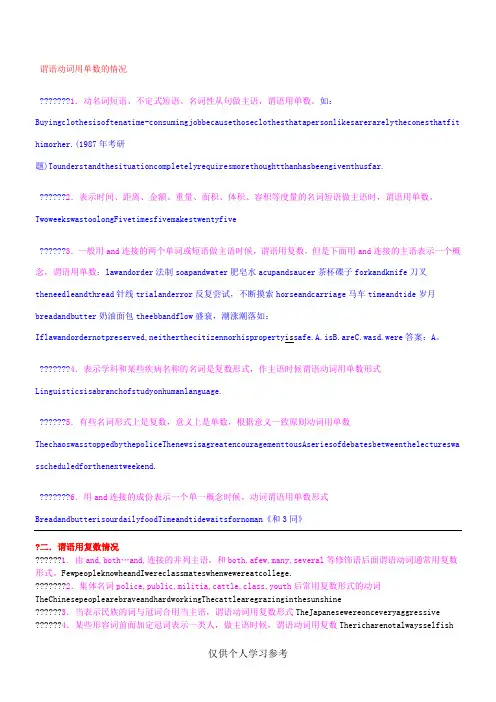
谓语动词用单数的情况???????1.动名词短语、不定式短语、名词性从句做主语,谓语用单数。
如:Buyingclothesisoftenatime-consumingjobbecausethoseclothesthatapersonlikesarerarelytheconesthatfit himorher.(1987年考研题)Tounderstandthesituationcompletelyrequiresmorethoughtthanhasbeengiventhusfar.??????2??????3岁月A。
???????4??????5???????6BreadandbutterisourdailyfoodTimeandtidewaitsfornoman《和3同》?二.谓语用复数情况??????1.由and,both…and,连接的并列主语,和both,afew,many,several等修饰语后面谓语动词通常用复数形式。
FewpeopleknowheandIwereclassmateswhenwewereatcollege.???????2.集体名词police,public,militia,cattle,class,youth后常用复数形式的动词TheChinesepeoplearebraveandhardworkingThecattlearegrazinginthesunshine??????3.当表示民族的词与冠词合用当主语,谓语动词用复数形式TheJapanesewereonceveryaggressive ??????4.某些形容词前面加定冠词表示一类人,做主语时候,谓语动词用复数Thericharenotalwaysselfish仅供个人学习参考5.不可数名词作主语,其前有表示数量的复数名词修饰时,谓语动词用复数Threemilliontonsofcoalwereexportedthatyear??三.谓语动词可用单数,也可以用复数的情况???????1.就近一致原则这种情况下,谓语动词使用单数还是复数取决于最靠近该动词的主语的单复数,存在这种情况的主要由以下几种可能:??????1)由连词either…or…;neither…nor…;whether…or…;notonly…but(also);or等连接的并列主语NeithermoneynorfamehasinfluenceonmeNotonlyyoubutalsoheiswrong???????2)在倒装结构中,谓语动词与后面的第一个主语一致Blockingtheopen-sidedporch,framedbytheenvelopingfog,standsatallgrave-facedpoliceman.Justoutsideth eruinsisamagnificentbuildingsurroundedbytalltrees.Althoughagreatnumberofhousesinthatareaarestilli nneedofrepair,therehasbeenimprovementinthefacili??????2??????3??????d.(1996??????4.??????5等等??????6???????可??????第二组;thenumberof+可数名词复数谓语用单数each/every+可数名词复数谓语用单数neither/eitherof+可数名词复数谓语用单数oneandahalf+可数名词复数谓语用单数??????第三组;morethanone+可数名词单数谓语用单数manya+可数名词单数谓语用单数???????第四组;thegreaterpartofalargeproportionof50%ofonethirdofplentyoftherestof谓语的数与of后面的名词一致???????第五组;(n)either…(n)or….notonly…..butalso……not…..but……谓语的数与主语的第二部分(即(n)or/butalso/but引导的后面部分)一致.???????注意比较:Morestudentsthanonehavebeenreferredto?????????????????????????????Morethanonestudentisgoingtobuythisbook仅供个人学习参考。
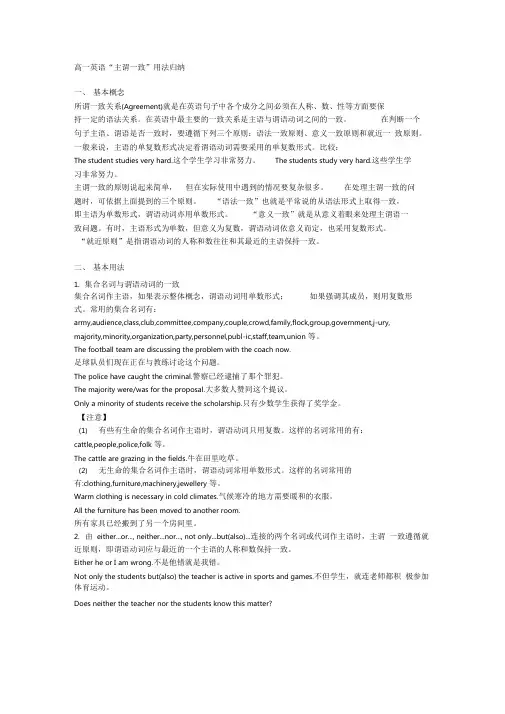
高一英语“主谓一致”用法归纳一、基本概念所谓一致关系(Agreement)就是在英语句子中各个成分之间必须在人称、数、性等方面要保持一定的语法关系。
在英语中最主要的一致关系是主语与谓语动词之间的一致。
在判断一个句子主语、谓语是否一致时,要遵循下列三个原则:语法一致原则、意义一致原则和就近一致原则。
一般来说,主语的单复数形式决定着谓语动词需要采用的单复数形式。
比较:The student studies very hard.这个学生学习非常努力。
The students study very hard.这些学生学习非常努力。
主谓一致的原则说起来简单,但在实际使用中遇到的情况要复杂很多。
在处理主谓一致的问题时,可依据上面提到的三个原则。
“语法一致”也就是平常说的从语法形式上取得一致,即主语为单数形式,谓语动词亦用单数形式。
“意义一致”就是从意义着眼来处理主谓语一致问题。
有时,主语形式为单数,但意义为复数,谓语动词依意义而定,也采用复数形式。
“就近原则”是指谓语动词的人称和数往往和其最近的主语保持一致。
二、基本用法1.集合名词与谓语动词的一致集合名词作主语,如果表示整体概念,谓语动词用单数形式;如果强调其成员,则用复数形式。
常用的集合名词有:army,audience,class,club,committee,company,couple,crowd,family,flock,group,government,j-ury, majority,minority,organization,party,personnel,publ-ic,staff,team,union 等。
The football team are discussing the problem with the coach now.足球队员们现在正在与教练讨论这个问题。
The police have caught the criminal.警察已经逮捕了那个罪犯。
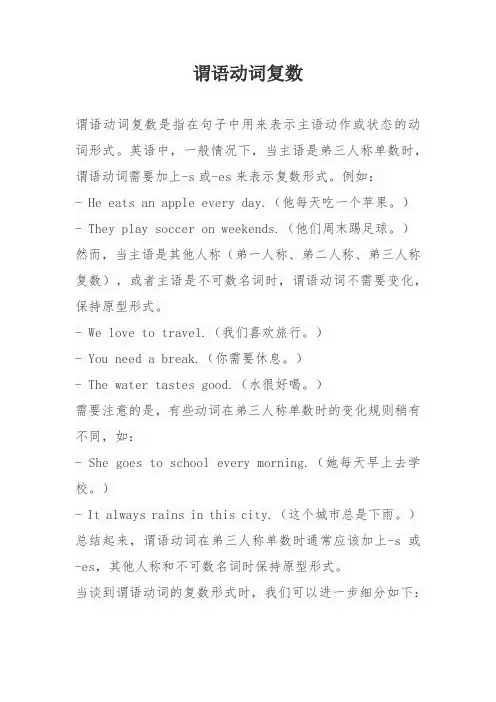
谓语动词复数谓语动词复数是指在句子中用来表示主语动作或状态的动词形式。
英语中,一般情况下,当主语是弟三人称单数时,谓语动词需要加上-s或-es来表示复数形式。
例如:- He eats an apple every day.(他每天吃一个苹果。
)- They play soccer on weekends.(他们周末踢足球。
)然而,当主语是其他人称(弟一人称、弟二人称、弟三人称复数),或者主语是不可数名词时,谓语动词不需要变化,保持原型形式。
- We love to travel.(我们喜欢旅行。
)- You need a break.(你需要休息。
)- The water tastes good.(水很好喝。
)需要注意的是,有些动词在弟三人称单数时的变化规则稍有不同,如:- She goes to school every morning.(她每天早上去学校。
)- It always rains in this city.(这个城市总是下雨。
)总结起来,谓语动词在弟三人称单数时通常应该加上-s或-es,其他人称和不可数名词时保持原型形式。
当谈到谓语动词的复数形式时,我们可以进一步细分如下:1. 一般现在时:在一般现在时中,弟三人称单数的谓语动词通常需要加上-s或-es。
例如:He plays the guitar.(他弹吉他。
)She watches TV every evening.(她每晚看电视。
)2. 现在进行时:在现在进行时中,弟三人称单数的谓语动词要加上-ing和-s。
例如:She is studying for the 弟.(她正在备考。
)He is playing soccer with his friends.(他正在和朋友踢足球。
)3. 现在完成时:在现在完成时中,谓语动词的复数形式与一般现在时相同,需加上-s或-es。
例如:They have traveled to ny countries.(他们去过很多国家。
“a of b”结构中,谓语动词的单复数形式取决于b的数。
如果b是可数名词的单数或不可数名词,那么谓语动词应该用单数形式;如果b是可数名词的复数形式,那么谓语动词应该用复数形式。
例如:
a part of b(b为可数名词单数或不可数名词):The water is 50% of the total amount.(水占总量的50%。
)
a part of b(b为可数名词复数):Many cars are made up of parts from different manufacturers.(许多汽车是由来自不同制造商的零部件组成的。
)
请注意,如果a和b都是可数名词,并且a和b之间存在一种“整体与部分”的关系,即a包含b,那么谓语动词通常使用复数形式。
例如:“The legs of the table are made of wood.”(桌子的腿是用木头做的。
)。
quantity of谓语动词单复数在英语中,谓语动词的单复数形式根据主语的单复数形式来决定。
因此,在使用“quantity of”这个短语时,需要提前确定它所描述的主语的单复数形式。
本文将探讨在使用“quantity of”时,谓语动词单复数形式的准确使用。
一、“quantity of”+可数名词复数当“quantity of”后面接的是可数名词的复数形式时,谓语动词应使用复数形式。
例如:1. A quantity of cars were parked outside.2. A large quantity of books were donated to the library.3. A significant quantity of apples were picked in the orchard this year.在这些例子中,主语分别是“cars”、“books”和“apples”,它们都是可数名词的复数形式,因此谓语动词都要使用复数形式。
二、“quantity of”+不可数名词当“quantity of”后面接的是不可数名词时,谓语动词应使用单数形式。
例如:1. A quantity of water was spilled on the floor.2. A large quantity of sugar has been added to the recipe.3. A significant quantity of oil was found in the ground.在这些例子中,主语分别是“water”、“sugar”和“oil”,它们都是不可数名词,因此谓语动词都要使用单数形式。
三、“quantity of”+可数名词单数当“quantity of”后面接的是可数名词的单数形式时,谓语动词的单复数形式要根据句子的语境来确定。
例如:1. A quantity of time has passed since we last spoke. (单数形式)2. A quantity of people were waiting in line for tickets.(复数形式)在第一个例子中,虽然主语是可数名词的单数形式“time”,但由于句子的语义是指“一段时间已经过去”,因此谓语动词应使用单数形式。
谓语动词和主语all the employees 保持一致。
介词except 是不能影响谓语动词的单复数的。
其他的用法你看看下面的讲述,相信你会懂的II .主语的“数”决定谓语动词的形式。
1.“不可数名词、可数名词单数、单数代词、不定式(短语)、动名词(短语)”或“从句”等作主语,用单数谓语形式。
e.g.①The work is important . 这项工作重要。
②To serve the country is our duty . 为祖国服务是我们的义务。
③How and why he left was a sad story . 他离开的经过和原因是一段伤心的经历。
2. 复数的名词、代词一般接复数谓语形式。
e.g.①The children are taken good care of . 孩子们得到很好的照料。
②They have gone to Chengdu . 他们去成都了。
II. 以“and ”或“both… and”连接的并列主语:1.通常作复数用。
e.g.①Plastics and rubber never rot . 塑料和橡胶从不腐烂。
②What he says and what he does do not agree. 他言行不一致。
③Both Tom and I are fond of medicine . 我和汤姆都喜欢医学。
2. 如果并列主语指的是“同一个”人(事、物、抽象概念),作单数用。
e.g.①The worker and writer has come . 这位工人作家来了。
②A cart and horse was seen in the distance . 远处能看见有一套马车。
③Truth and honesty is the best policy . 真诚是最好的策略。
3. “and”前、后的单数词语都有“each,every ,many ,a ,no”等修饰时,仍作单数用。
e.g.①Every boy and every girl enjoys equal rights here.这里每个男孩和每个女孩都享有平等权益。
②No teacher and no student is excused from taking part in the activity .没有哪个教师或学生可以免于参加这项活动。
Ⅳ. 主语前、后加表“数、量”等的修饰语时:1. a)“many a + 单名”接单数谓语:“a good (great ) many + 复名”接复数谓语。
e.g.①Many a fine man has died for it . 许多优秀战士为此献出了生命。
②A great many parents were present at the meeting . 许多家长出席了会议。
b)"a / an + 单名+ or two " 大多接单数谓语:"one or two + 复名"接复数谓语。
e.g.①Only a word or two is (are )needed. 只需说一两句。
②One or two reasoms were suggested . 提出一两条理由。
c)"a / an + 单名+ and a half"常接单数谓语;“one and a half +复名”多接复数谓语。
e.g.①A year and a half has passed . 一年半已过去了。
②One and a half tons of rice are sold . 已卖了一吨半大米。
d)"more than one + 单名"大多接单数谓语。
e.g.①More than one person was (were )absent . 不止一个人缺席。
"more + 复名+ than one "接复数谓语。
e.g.②More students than one have been there . 不止一个学生去过那儿。
"more than two (three,…)+复名" 接复数谓语。
e.g.③More than one hundred students have attended the concert . 不止一百名学生听了这场音乐会。
2 ,主语前加表示“单位、度量”的短语如“a kind (sort / type / form /pair /cup /glass /piece / load / block / box / handful / quantity / ton / metre /… )of”等时,表示“单位、度量”的这个名词的单复数决定谓语形式。
e.g.a)①There is only a small quantity of paper (books ) left . 只剩下少量的纸(书)了。
②Large quantities of water are needed . 需要大量的水。
b)①This kind of apple is sweet . 这种苹果甜。
②This kind of apples is (are) sweet . (大多依kind ,作单数用)③These kind(s) of apple(s) are sweet . (总作复数用)但:Apples of this kind are sweet . (总作复数用)3. 主语后接“with…”等构成的短语修饰成分时:谓语仍须与这类短语前的“主语”一致。
可构成这类短语的常用“with ,along with ,together with ,as well as , but , besides , except ,added to , including , like ,no lessthan , rather than , more than ”等。
e.g.①A woman with two children has come . 一位妇女带着两个孩子来了。
②I as well as they am ready to help you . 不仅他们,我也愿帮助你。
4. "one of + 复数名词+ 定语从句":1)定语从句的先行词通常是这个“复数名词”,因此从句的谓语用复数形式。
e.g.①This is one of the best novels that have appeared this year . 这是今年出版的最佳小说之一。
(关系词“that”代“novels”)②He was one of the boys who were praised . 他是受表扬的男孩之一。
2)若“one”前加“this, the ,the only ”等时,定语从句的关系词指代one,作从句主语时,接单数谓语。
e.g.He was the only one of the boys who was praaised .他是男孩中唯一受到表扬的。
(关系词who 代the only one )【意义一致原则(Notional Concord)】I. 集合名词作主语时:(参见“名词”部分)1. 有些通常作复数用(不变词形)。
如:“people , police , cattle (牛,牲口),folk , youth , militia (民兵)”,等。
e.g.The police have caught the murderer .警方已捕获凶手。
2. 有些指“整体”时作单数,指其中的“成员”时作复数(不变词形)。
如"army , audience(听众),class ,club (俱乐部) ,company(公司), committee(委员会) ,crew ,crowd ,staff(员工) ,family ,public ,government ,group ,party ,union ,couple ,population ,team ."等。
e.g.①Our family is a happy one . 我们有个幸福的家庭。
②The family are early risers . 这家人都起得早。
③The public are (is )requested not to litter . 请公众不要乱扔废弃物。
但上述集合名词也可有复数形式。
如:families , two classes .等。
有些变复数形式后意义不同。
如:peoples多个民族。
youths男青年。
folks 亲友。
II. 代词作主语时:(参见“代词”部分)1. 不定代词"each ,one , much, (a)little ,elther ,neither ,another ,the other(+单名)"等常作单数用。
它们所修饰的主语也作单数。
e.g.①Each of the girls (Each girl) has a new hat . 每个女孩都有顶新帽子。
②Neither plan suits me .③Neither of the plans suits / suit me . 两个计划都不适合我。
2. 下列复合不定代词一般作单数用:“someone ,somebody ,something ,anybody ,anyone ,anything ,everybody ,everyone ,eveything ,nobody ,no one ,nothig ”等。
e.g.①Is everybody here ? 都到齐了吗?②There was nothing special then. 那时没什么特别情况。
3. 下列不定代词作复数用:“(a)few ,many ,several,both”等。
e.g.①Few (of the guests ) were familiar to us . 没几个(客人)是我们熟识的。
②Both / Both (of ) these are interesting . 两部影片都有趣。
4下列代词须视其“具体所指”来决定单、复数:1)“what ,which ,who ,whose ”等。
e.g.①Who is your brother ?你兄弟是谁?②Who are League Members .哪些是团员?2)"all , some ,more ,most ,any ,none ,a lot(of ), lots (of ),"等。